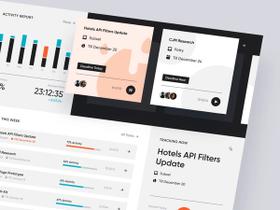Sports clubs, professional associations, or interest groups face certain challenges in managing their activities. Since member registration and billing, as well as event planning and communication, are among the tasks that can contribute to the growth and satisfaction of club members, partnering with our fitness app development company can help manage all these activities more effectively.
This is where specialized club management software plays a crucial role. Unlike off-the-shelf software, specialized software can be tailored to the specific needs of your club, allowing you to create, expand, or optimize workflows according to your unique way of working and development, as well as optimize operations.
In this article, we will look at what club management software development is, why it is important, what challenges you may face, and how a specialized platform can make managing your club most effective. Let's begin!
🧩 What Is Club Management Software?
Club management app is a digital solution designed to simplify and centralize the day-to-day operations of membership-based clubs and organizations. Whether it's a sports club, professional association, or hobbyist community, these platforms help administrators manage members, payments, events, communications, and other important tasks — all in one place.
At its core, club management system software acts as a digital dashboard that replaces manual spreadsheets, disparate tools, or paper-based processes. It streamlines administrative workflows and creates a more organized, scalable way to manage clubs of any size.
Whether you run a sports club in your neighborhood or an organization with multiple branches, club management software can be customized to your specific workflows, ensuring smooth operations behind the scenes.
Thinking about building your own club management solution?
Contact Us!
🌟 Benefits of Club Management Platforms
Investing in the development of a reliable club management platform offers significant benefits that affect all aspects of club operations — from increasing member satisfaction to stimulating growth and optimizing work processes. Below, we will look at the main advantages that modern software solutions offer clubs of all types and sizes.
Member Experience Optimization
The success of any club is based on the positive experience of its members, which is increasingly prioritized in today’s fitness industry transformation and discussed regularly at leading fitness industry conferences. Club experience management software enhances member satisfaction by providing seamless access to services and information.
Features such as easy online booking, real-time notifications, and mobile app accessibility — often accessible through a free trial — allow club members to interact on their own terms.
Operational Efficiency
Administrative staff can face challenges when performing repetitive routine tasks. A club management system automates routine tasks such as invoicing, attendance tracking, and report generation, allowing staff to focus on more important tasks.
Revenue and Retention Growth
Proper membership management software will help ensure financial well-being. Membership renewal reminders, integrated credit cards, and automatic billing reduce payment delays, improving cash flow.
Centralized Data Management
Member records, event details, accounts, and communications are also managed separately, which often leads to data fragmentation and inconsistencies. Club management solutions is a place where all relevant information is displayed in a single, reliable interface.
In addition to improving data accuracy, this centralization also means increased compliance and improved reporting. Not only does this provide a single source of truth, but it also simplifies auditing and performance monitoring, making management more transparent and efficient.
Want to optimize your club operations and boost member satisfaction? We’ll help you design software that delivers real value to your members and your business.
Contact Us!
⚠️ Challenges in Club Management Software Development
Creating effective software for clubs comes with a number of critical challenges that can impact the success of the project. Recognizing these obstacles early in the process allows teams to plan ahead and overcome them. Let's take a look at the main challenges in a brief table:
Challenge | Description |
|---|---|
Balancing Customization & Usability | The needs of clubs are specific and very diverse, so developing flexible software that is easy to use for everyone is a challenging task. |
Feature Integration | The task of integrating a large number of extremely complex functions (calculations, planning, communications, security, etc.) into a single system requires high compatibility and data flow requirements, which is not an easy task from a technical point of view. |
Data Security & Compliance | Processing club member data with access to confidential information requires a high level of security and compliance with regulations such as GDPR, which are subject to constant change and also require attention. |
Scalability & Performance | The infrastructure must be designed in such a way that it does not slow down or fail when the number of users increases, as well as when large amounts of data are involved, so planning and testing are necessary. |
Budget & Timeline Management | Changing requirements and unresolved issues that need to be addressed in software management, in most cases, increase costs and delays in delivery if not taken seriously. |
These challenges can only be successfully overcome with effective teamwork, highly skilled development teams, and effective planning throughout the project lifecycle.
🛠️ Key Features of Club Management Software
A well-designed club management app includes a comprehensive set of features — many of which overlap with the core features of fitness app platforms — designed to optimize operations, increase member satisfaction, and support club growth. Below are the key features offered by most modern platforms, along with real-world examples and relevant statistics.
Attendance Tracking
Accurate attendance tracking helps clubs monitor member participation and engagement. Whether through mobile check-ins, QR codes, or manual data entry, real-time attendance data allows clubs to optimize resource allocation, improve event planning, and maintain active member records.
Payment Processing
Simple and secure payments are essential. Seamless integration with major payment gateways allows clubs to easily manage membership, subscriptions, and merchandise sales. Automated billing, credit cards, and subscription plans simplify the billing process with flexible payment gateways, reduce administrative costs, and improve member experience and satisfaction.
Booking and Scheduling System
An easy-to-use booking and reservation system allows club members to sign up for classes, reserve facilities, or schedule an appointment with a trainer or staff member. Additional options such as calendar support, waiting lists, and reminders make the process seamless and reduce the likelihood of no-shows. Club members have a better experience visiting your club thanks to the ability to book online.
Inventory & Equipment Management
For clubs that deal with physical assets, tracking inventory and equipment usage is extremely important. This feature helps avoid losses, schedule maintenance, and maximize equipment availability. Inventory management combined with scheduling eliminates waste of resources, leading to increased efficiency.
Reporting and Analytics
Data-driven decision-making is achieved through robust reporting and analytics tools. Club management software provides customers with detailed information on employee demographics, attendance, financial history, and more. Personalized reports and graphical dashboards allow club managers to understand which aspects of their business need improvement and why (as well as how to mitigate potential problems).
Coach & Staff Management
Coaches, instructors, and support staff can be managed most effectively using a separate administrative panel. Scheduling, payroll, performance tracking, and communication software ensure staff efficiency and accountability.
Health & Safety Management
Health indicators are extremely important, and with BLE fitness devices integration, clubs can automatically track and sync key metrics alongside incident reports, medical examinations, vaccination tracking, and the like. Adding these tools to your club management system creates a safe environment and increases customer loyalty. After all, you care not only about your business but also about your customers.
Need powerful features tailored to your club’s workflow? Let’s build the tools your team and members actually need — custom and scalable.
Contact Us!
🧑💻 How to Develop Club Management Software
In this section, let's dive into the development and look at all the stages of development on the way to creating a custom club management system.
Define Requirements and User Roles
Before starting club management software development, it is important to define the detailed requirements of your custom club software clearly. You need to know:
- What types of clubs will be served on the platform (e.g., sports, professional, hobby)? For instance, if your goal is to make a sports team management software, your feature list may look very different from a professional association.
- What are the main features that should be included? What additional innovations can be added to attract customers?
- Who is the target audience of the platform? For example, for sports clubs - club staff, club managers, club members, coaches.
Of course, there are many more internal processes at this stage. Still, thanks to the answers to these three basic questions, the next steps in the development of the application will have a solid foundation. They will become the basis for mastering UX and secure user authorization.
Choose Platform
The next step is to choose the technology stack and platform type:
- Mobile, web-based, or hybrid?
- Will it be a cloud-based SaaS application or a standalone application?
- Will it include ready-made solutions or existing third-party applications, such as payment gateways, calendars, and so on?
Whether you're developing a club management system or aiming to build a corporate wellness app, an online platform with a mobile app offers the optimal combination of convenience and productivity. And for creating both a web and mobile app, a cross-platform platform such as React Native can save a lot of time and money. It will allow you to keep more than half of the code between iOS and Android, ensuring unified performance and reducing time to market.
UX/UI Design for Club-specific Use Cases
Design is not only a matter of appearance, but also a matter of convenience and ease of use — principles central to effective fitness app UX/UI, as emphasized in our fitness app development guide.
The set of functions in a club management software can be extremely specific: scheduling squash court reservations, viewing training manuals, tracking team equipment, etc. Designers must create interfaces that are, on the one hand, adaptable enough to accommodate the diverse scenarios typical of a particular club and, on the other hand, easy to use.
At this stage, the most important things are wireframes, user testing of prototypes, and mobile responsiveness. Accessibility standards also contribute to good design, especially for audiences of different generations.
Core Development & Feature Integration
It's time for development. The beginning of development usually consists of creating the backend infrastructure (database, API, user management) and moving on to developing the features you have already defined in the previous stages.
Developers typically use a range of proven technologies and tools to develop and implement these features. Below are some of the most common tools and technologies for developing club management software (we will discuss them in more detail in the following sections):
These tools allow developers to create scalable, secure, and efficient systems that can be extended to member billing, real-time event updates, and more, whether you’re building a member dashboard or want to make an app for fitness devices in React Native.
Testing, Compliance & Security Checks
Testing can be described as an extremely important stage after the development and implementation of features, especially when addressing technical challenges for our IoT mobility, where security and interoperability are critical. It includes:
- Functional testing to verify the performance of all features.
- Security audit to protect important member information.
- Testing for compliance with requirements such as GDPR or ADA that apply in your region (these are compliance requirements).
It is also advisable to conduct testing on a small group of early users before the actual launch.
Deployment & Ongoing Support
Once testing is complete, the platform can be implemented. This includes:
- Creating working conditions;
- Migrating key information (if necessary);
- Training users/administrators;
- Launching web and mobile applications.
However, development does not end with launch. Clubs change, and so do their requirements. Long-term support involves making changes every few days, taking user feedback into account, tracking performance, and adding new features as the club expands.
🔒 Data Privacy & Security
When developing a club management system, user data security is not only a technical issue, but also a matter of trust. Clubs process sensitive data such as user profiles, payment details, medical histories, and communication histories. Misuse of such data can lead to loss of reputation, fines, and even lawsuits. That’s why investing in club security software is critical to ensure comprehensive protection at every level.
Below, we have compiled a list of key issues that you should consider:
Secure Authentication and Role-Based Access | Configure data access restrictions based on user type. This includes multi-factor authentication (MFA), OAuth, and role-based permissions, where access can be restricted to trainers, members, administrators, or guests. This reduces the risk of internal information leaks. |
Data Encryption | Data must be encrypted (during transmission and storage) in accordance with modern standards such as TLS 1.3 and AES-256. This ensures that if data is intercepted or accidentally obtained, it will still be unreadable. |
GDPR and Local Compliance | You must comply with the data protection requirements, depending on your target region, of the GDPR, CCPA or PIPEDA. This includes:
|
Secure Payment Processing | In the case of clubs that use credit card payments or recurring billing, it is very important to consider only integrating with PCI-compliant payment providers such as Stripe or PayPal. You should not store payment information in your app, but instead use secure tokens generated by the payment gateway. |
Regular Security Testing | Your maintenance plan should include penetration testing, vulnerability scanning, and automated security audits. This helps you identify and address risks before they can be exploited. |
Cloud Security Measures | When using a cloud infrastructure such as AWS or Google Cloud, ensure that Identity and Access Management (IAM) is configured correctly, that encryption is set as a default setting, and that abnormal access is controlled using the built-in AWS GuardDuty or Google Cloud Armor services. |
Ensuring the security of user data is not just an option, but the basis for creating a modern and stable platform for club management.
Ready to take the first step toward development? Our team will guide you through every stage — from planning to launch and beyond, with transparent pricing available throughout.
Contact Us!
🧬 Tech Stack for Club Software Development
In the previous section, we discussed the tools and technologies used to create a club management program. Let's take a closer look at where you might need these tools and what problems they can solve:
- React Native - Ideal when you want to quickly make a wellness app or a club platform for iOS and Android using unified code and lower costs.
- Node.js - Supports the creation of high-performance servers that are needed to support real-time functions such as attendance synchronization or live course listings. Scales effectively as the number of users increases.
- PostgreSQL / MongoDB - Use PostgreSQL for structured data such as memberships, bookings, or payments. MongoDB is suitable when you need flexibility, such as storing dynamic forms, notes, or custom attributes.
- Firebase is a great solution when you need to use login apps with easy deployment of push notifications and real-time updates, especially when working in an MVP or prototype environment.
- Stripe/PayPal SDKs - Process secure credit cards, subscriptions, and refunds.
- Twilio / SendGrid - Activation of SMS, emails, or notifications in the app
- AWS / Google cloud - Provides scalable and secure file storage, backup, and performance monitoring infrastructure.
Not sure what tech stack is right for your club app?
Contact Us!
💰Cost of Club Management Software Development
The cost of creating an individual club management system — just like the costs to create a fitness app — depends on many factors, from the technical scope to the place of development. Here is a brief overview of the main factors that affect the cost:
- Scope of functions: the more advanced the platform, the higher the cost (for example, simple booking vs. full analytics).
- Platform type: web platforms are cheaper than mobile + web; using React Native helps to reduce costs on mobile devices.
- Team location: hourly rates range from $25 to $180 depending on the region.
- Deadlines and iterations: more edits = more time.
- Post-launch maintenance: Ongoing app maintenance costs usually amount to 15-25% of the initial development cost per year.
For greater transparency, here is a breakdown of the approximate number of development hours by function:
Estimated Development Time by Feature
Feature | Min Hours | Max Hours |
|---|---|---|
User Authentication & Roles | 40 | 80 |
Attendance Tracking | 30 | 60 |
Payment Processing | 40 | 100 |
Booking & Scheduling System | 60 | 120 |
Inventory & Equipment Management | 30 | 60 |
Reporting & Analytics | 50 | 100 |
Coach & Staff Management | 40 | 80 |
Health & Safety Management | 30 | 70 |
Admin Panel / Dashboard | 40 | 100 |
Mobile App (React Native) | 120 | 200 |
Testing & QA | 40 | 80 |
Deployment & Documentation | 20 | 40 |
If you assume a flat rate for a development team of $60 per hour, a simplified MVP that takes approximately 540–600 hours will cost you $32,400 - 36,000 – and partnering with an MVP custom app development company ensures this early version is both cost-effective and scalable. To get a full-fledged and scalable platform that requires 1000 to 1200+ man-hours, you will have to spend approximately $60,000-72,000 or more.
🔮 The Future Trends for Club Management Software
Club management software is a dynamic sector, so you need to always be ahead of the curve and anticipate future trends that will shape the platforms of the future. Below are some of the main future trends to watch out for:
AI-Powered Personalization
The use of artificial intelligence (AI), one of the key ideas for fitness apps, is changing the way clubs interact with members. AI can provide a highly personalized experience through individualized workout or event recommendations, as well as chatbots that automate member support.
Big Data Analytics and Insights
Future club management systems will use big data and predictive analytics to help clubs plan more efficient operations, know when to expect a surge in visitors, analyze member behavior, and improve financial planning based on real-time information.
Cloud and Serverless Architecture
Moving beyond traditional hosting solutions, cloud and serverless architecture will not only provide faster deployment, improved scalability and lower infrastructure costs, but will also help clubs eliminate small technical costs and allow them to scale quickly.
Enhanced Mobile Experience
With mobile devices still the most popular, future apps will focus on richer and more interactive experiences such as AR/VR for virtual tours, social tools for community building, and easy mobile payments.
Focusing on Data Privacy and Security
With increasingly secure regulatory requirements and cybersecurity threats, new club software will focus on built-in compliance features, end-to-end encryption, and well-executed privacy settings, ensuring member information is secure and clubs worldwide are compliant.
Modeling with IoT and Wearables
The popularization of wearable fitness devices and IoT in the fitness domain provides clubs with an unprecedented opportunity to track the health of their members.
Want to stay ahead of industry trends? We’ll help you build a future-proof platform powered by innovation — AI, IoT, analytics, and more.
Contact Us!
❓ Why Choose Stormotion?
At Stormotion, we have experience in developing high-level features that encourage participation and engagement, which is one of the key pillars of a club management tool.
An example of this in our work at Yangol is the implementation of real-time feedback features that allow people to directly share their opinions, rate their experiences, and instantly communicate and share this within the app. This type of real-time feedback cannot be underestimated by clubs that want to increase customer satisfaction, learn about issues and resolve them quickly by creating an active and collaborative environment.
We have also created powerful KPI and OKR monitoring systems that allow an organization to track, measure, and analyze the key performance indicators of new employees using real-time metrics. In the case of clubs, these comparable metrics can be membership growth, attendance, classroom utilization, and revenue goals, giving managers the ability to make data-driven decisions and optimize the business very successfully.
Through the implementation of these dynamic feedback and performance monitoring systems, Stormotion allows your club management platform to remain responsive, open, and focused on continuous progress.
👂 Takeaways
Creating your own platform for club management and administration can be a good solution with long-term effects. It will help your business automate processes, staff work, set up payment systems, and so on.
However, developing a club management platform is a rather complex task, which, in addition to the application development process and all the important functions, also requires compliance with all user data protection regulations.
Let's summarize everything you've read above in our article:
- Custom software can be created to perfectly meet the unique needs of your club, improving the member experience and operational efficiency.
- Basic features such as attendance tracking, payment processing, booking systems, and personnel management are essential for a modern club platform.
- Using the React Native framework for cross-platform mobile development will help you save time and money.
- Protecting club member data with encryption, GDPR compliance, and secure payment integration helps build trust and prevents data leaks.
We hope you found our article on custom club management software development useful. But if you still have questions or are looking for a team of developers to help you bring your idea to life and improve your business, write to us and we will discuss all the details together!





![Stormotion client David Lesser, CEO from [object Object]](/static/93e047dadd367691c604d8ffd1f54b58/b0e74/david.png)


